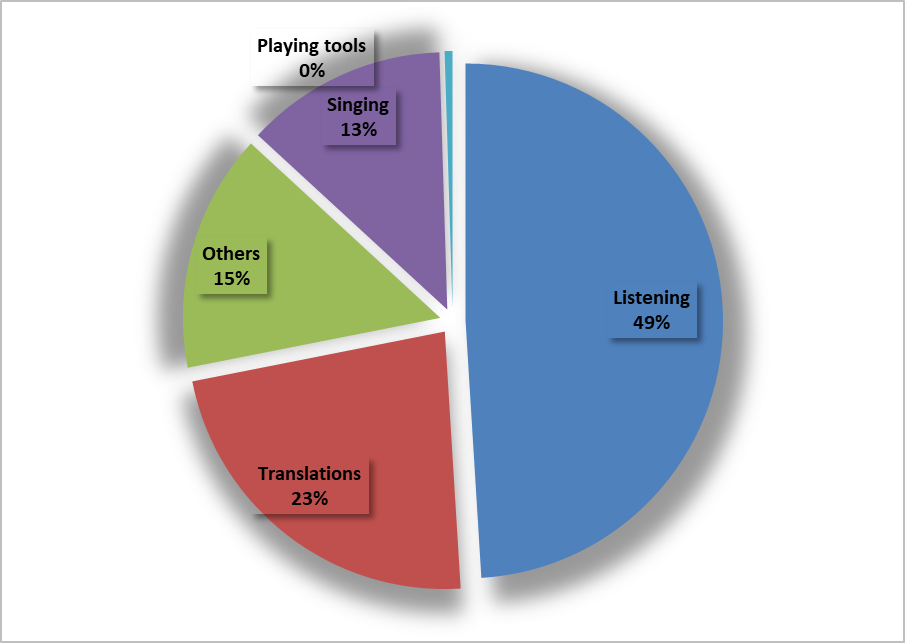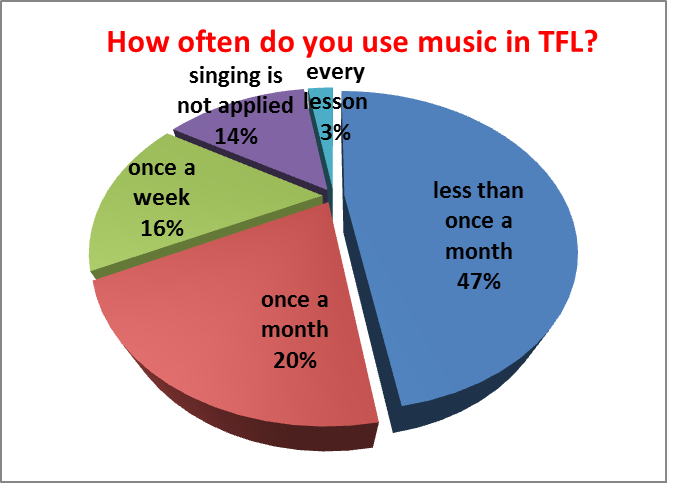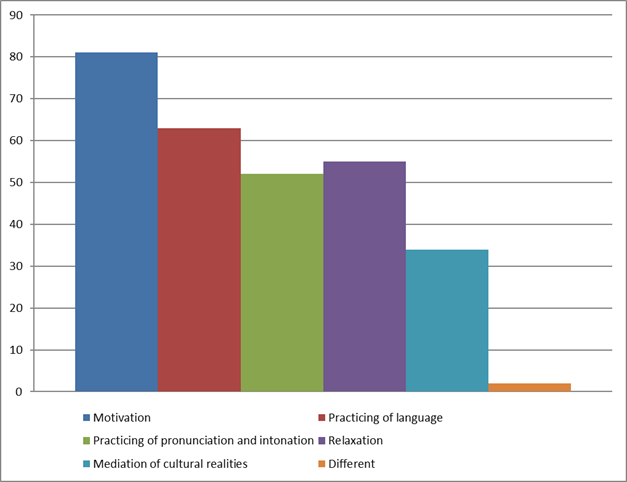Abstract
Music is a phenomenon that deserves thorough studies. It serves not only educational and development purposes during foreign language teaching (FLT), but also the development of the pupils’ personality. Using music is connected with the development of emotional intelligence; it positively influences pupils’ aesthetic emotions and helps them to build ethical basis of their personality, attitudes and opinions. Various methods how to use music in FLT is, however, closely related to the diversity of the teachers’ approach. This study describes the teachers’ attitudes to the use of music in FLT and how Czech teachers apply music in their lessons. Music has a lot in common with foreign languages. It has been proved that it can help well, for example, when practising the suprasegmental features of foreign language. We used a questionnaire in our research to depict the aspects which play the most significant role for the Czech teachers when using music in FLT. Our research aim was to outline various possibilities how to use music in FLT and finally to find out whether the teachers did or did not use music when practising the suprasegmentals using music. Surprisingly, according to our findings, music serves mainly as a motivational and relaxing aspect in FLT. Our research outcomes can be valuable for the teachers when considering their lesson plans, for their inspiration and their reflection on the existing methods in FLT. Besides all these facts, teachers’ positive relationship to music and its use in FLT is emphasised.
Keywords: Second languageFLTmusicteaching methods
Introduction
Music is a discourse which crosses language barriers and connects people all around the world. It is a universal topic of conversation across cultures. (Patel, 2008) Music and language have a lot in common. They are in some aspects very similar and in some aspects they interrelate well. Many research studies and findings support the hypothesis that language and music structures are very closely linked and processed similarly in the brain. In FLT, it is essential to study and learn not only morphological and syntactic structures, but also appropriate pronunciation, accent, intonation, melody, stress, tone, word juncture and so on. Such prosodic features of language could be taught and practised with the help of music.
The presence of music in FLT has a wide range of application. It is considered as a powerful mean
Presence of music in FLT is important from various points of view such as motivation, language reception and production, emotions and intensive language perception. All these aspects influence not only the learners learning a foreign language but also the teachers of foreign languages.
Music as a powerful tool in FLT can activate learners and improve their communication skills. Furthermore, it encourages positive learner engagement and learning motivation because music can create a friendly and calming atmosphere. Music as a source of authenticity can contribute to better understanding and learning the foreign languages especially during practising language melody, intonation and rhythm.
Last but not least, music develops pupils’ creativity and helps pupils to stay lively and talkative. Music can be used in various ways and it is a suitable tool for practising certain language skills.
This study in using music in FLT was deeply influenced by Pattel´s opinion (2008, pp. 3-4): “The central role of music and language in human existence and the fact that both involve complex and meaningful sound sequences naturally invite comparison between the two domains.”
The learning process is a dynamic system that is influenced by many factors. One of them is the role of a teacher who is directly involved in teaching, and is the primary mover of the educational process and, last but not least, has an important motivational role.
There exists a vast number of teaching methods in FLT. We have focused on the ones that apply music either as the main teaching tool, or as a facilitative material. FLT is based on the interaction between the teacher and the learner; therefore, some methods are directly linked to their mutual cooperation. Nevertheless, it is the teacher who plays a dominant role when teaching the foreign language and who should think about the language taught. As Tauchmanova says (2016), “We can come to the conclusion that language teachers should be constantly increasing their language awareness because then they can make more competent judgements and decisions in their teaching process.” Choděra (2000) states the teacher through his/her language and language behaviour represents the individual, social and historical distinctive world. Further on, he points out that it is the teacher who has to be able to reflect his/her personal objectives, professional and social roles, understanding of the others and their close relationships, ability and willingness to enter the dialogue between himself/herself and the world, and finally to learn much about himself/herself.
Music in language education can help the learners develop musical abilities that manifest themselves in the form of hearing, rhythm, singing, and intonation particularly in foreign languages. Music in foreign language instruction also fulfils a motivational function that can be used to practice the correct pronunciation, which should take place at the very beginning of foreign language teaching. Phonetics in foreign language teaching cannot be seen in isolation; it is important to incorporate it into grammar or lexical exercises, reading, writing and speaking in a given foreign language. Besedova (2016) has categorized these aspects into the three groups:
Reception and production aspects in foreign language which include mainly pronunciation, vocabulary, grammar structures, listening and reading comprehension together with oral and written production.
Aspect of intensive perception which covers all aspects participating actively in teaching process such as motivation, patience, fantasy, creativity, memory, concentration, empathy etc.
Intercultural learning aspects including related fields such as literature, art, film, geography, analogy, analyses, communication, spontaneous dialogues etc.
All the above mentioned points form the integral part of FLT and they all can be used to link music with the learning of foreign languages. However, the majority of the teachers use music mainly as a motivational element. Unfortunately, the other aspects we labelled as reception and production aspects, intercultural aspects and aspects of intensive perception do not play almost any role for the teachers of foreign languages even if we consider the differences among the foreign languages and the stages of learning.
The main commonalities between music and foreign language are melody and rhythm. Perner (2014, p. 313) characterizes the two terms as follows, claiming that the melody often refers to the intonation of the speech, while the rhythm is associated with an individual speaking with regard to its segmentation, tempo, and pauses. Kienzler and Kumpf (2004, p. 28) go further in their statements and say that a differentiated and thorough listening to the melody and text is a prerequisite for the proper creation of unknown phonemes. Based on our experience and research, we believe that music in the form of songs, rhyming rhymes, musicals, classical music, various genres of songs and many others can be easily integrated into foreign language teaching. Children's songs are particularly suited to primary language teaching because we assume that little children are very happy to sing while practicing not only their memorial skills, but also strengthening the perception of music and foreign language. For older pupils, we see the usage of modern songs, musical melodies or classical music in its modern modified version as a very productive issue. Young people aged between 10 and 18 are engrossed with music, which causes a special emotional enthusiasm at this age.
The results of numerous studies and research support the assumption that the processing of linguistic and musical structures is closely intertwined and that similar processes are common in the brain. In the area of foreign language learning, it is very important not only to learn the correct grammar and syntactic structures and vocabulary, but also the correct pronunciation, accent, intonation, and speech melodies play a significant role in acquiring a foreign language. The prosodic features of the language can be mediated through music.
Problem Statement
Despite the numerous benefits of using music in FLT, there any hardly any serious efforts made by teachers to use this technique in their classes. The reason for this is not solely the teachers’ fault. There is a general disinclination to incorporate music as a FL teaching technique among teacher trainers, curriculum developers and educational policy makers. While music may be mentioned, it is only in passing with no serious effort given to how to appropriately incorporate music into the FL curriculum; This study was undertaken address this gap and to provoke more further research into this area in FLT.
Research Questions
Our basic research question was “What potential does music have in foreign language lessons?” We are aware of the fact that the teachers of various foreign languages at primary and secondary schools have different evaluation criteria concerning the usage of music in their lessons. Therefore, their attitudes may vary. Being highly interested in teachers’ concrete opinions, the following question guided our hypotheses: “How do you usemusic in foreign language lessons?”
We hypothesised that
H1: The teachers of foreign languages rarely use music in their lessons and if they did, it was only as a source and tool for relaxation.
H2: The motivational aspect of music plays higher role for the teachers than the aspect of language production and perception.
Purpose of the Study
The purpose of this study is to present the findings resulting from our study into the impact of using music in FLT. We have highlighted in our article that using music in FLT is in hands of the teacher and his/her positive attitude towards the music. For these reasons we have focused on the relationship between the teacher and music in our research and we have observed which aspects play a significant role for selection and usage of music in FLT. We hope that the results of this study will not only lead to further studies on the use of music in teaching foreign languages, but that they will also provide some impetus for foreign language teachers. Music does not necessarily have to serve as a motivational or relaxing tool in foreign language teaching, but can be used mainly for training suprasegmental phenomena in language (some teachers are not even aware of this fact as is evident from the study);
Research Methods
The data for this study was collected with a questionnaire. The questionnaire consisted of five parts:
Socio-demographic information
The use of literary texts in FLT
The use of music in FLT
The use of regional studies in FLT
The use of pictures in FLT
The questionnaire contained closed questions with a choice of answers, using scaling options. This study focused on data processing from parts one and three and these collected data were evaluated quantitatively. Subsequently, interviews were conducted with teachers, which were conducted as qualitative research, but this is not the main purpose of this study.
Our research was done with 111 teachers (89 females, 22 males) of foreign languages at Czech primary and secondary schools. The foreign languages were English (54 teachers), German (27 teachers), Russian (16 teachers), French (6 teachers) and some others (8 teachers).
Findings
Figure

The main focus of using music in FLT lies in the teacher's own attitudes towards music. From Figure

Figure

According to our study results, we have found out that teachers of foreign languages rarely use music in their lessons and if so then only as a sort of learning motivation. These findings have confirmed our first research hypothesis that teachers of foreign languages rarely use music in their lessons and if they did, it was only as a source and tool for relaxation. Thus, we can explain our second hypothesis that the aspect of motivation plays higher role than the aspect of language production and perception. Such findings have revealed a great lack in FLT in the Czech Republic, because we are strongly convinced that music should play much bigger role when practising especially suprasegmental features.
Conclusion
The study results have shown that music, despite all its benefits, does not play an important role in the FL classroom. The study did not present the reasons for this lack but it can be concluded that this is a great loss to the learners in terms of the linguistic and educational process. Perhaps one of the reasons why music is not used as often as it should be is because the teachers are not trained in the proper techniques to incorporate music into FL lessons.
Based on many foreign and local studies we believe that music can be easily integrated into FLT, for example in the forms of various songs, rhymes, musicals, classical music styles and so on. Particularly, nursery rhymes work well at the beginning of early foreign language studies because pre-school children love singing. On one hand, they practise their memory abilities and, on the other hand, they strengthen perception of foreign language through music. Speaking about primary school-age children, we see modern songs, musicals or classical music variations as very effective in FLT. Finally, the period of puberty and adolescence triggers emotional enthusiasm, when students of this age listen to a lot of popular music. The teachers should be aware of all these facts and apply music in their teaching activities.
Music in all its aspects influences our life and at the same time it could serve as an effective tool in education as well as in free time activities. If teachers know how to apply music effectively in their lessons, they can achieve informative and formative educational targets better. Music motivates, makes pupils more active and serves as an effective exercise for practising pronunciation, rhythm, intonation and fluency. Wisely chosen songs can even strengthen the grammar structures or build the vocabulary range of the target language.
However, the use of music in FL lessons need careful planning from the choice of songs to the range of activities to be implemented in the class. Criteria need to be provided to help the teachers to select suitable music in FLT which means specifically what kind of music for what age, for what language level, and so on. Teachers tend to use music only according to their previous educational or teaching experience. The main criteria the teachers should consider are the aims and objectives of the teaching process. In our opinion, suitable music for FLT could be as follows:
Melody should be simple, easy to remember, without wide vocal range.
Lyrics should be considered according to the pupils’ language level. It should not contain too many unknown and complex grammar structures and the vocabulary range should correspond to the pupils’ language level.
It is important not to forget the age of pupils. For beginners and younger children, songs with simple lyrics containing frequent repetitions are recommended. For older children, more appropriate modern melodies with the topical lyrics and the singers close to the pupils’ generation can be used.
Finally, the didactic value should not be overlooked. Lyrics should have a certain link to the learning topics such as similarities with the theme, vocabulary or even grammar.
To sum up, we can say that music leads to the development of various musical abilities such as rhythm, intonation, listening and singing and the first three mentioned play an important role in FLT. Besides that, music also plays a motivational aspect and it can serve from the very beginning, as a tool for practising pronunciation. Consequently, the phonetics elements should be integrated into the grammar or lexical exercises, into the reading, writing and oral productions. Using music in FLT is connected with the development of the learners’ emotional intelligence, aesthetics, and builds their personality, attitudes and opinions. Music can influence FLT very positively and it can help teachers in many above mentioned aspects.
References
- Altenmüller, E. (2018). Vom Neandertal in die Philharmonie. Warum der Mensch ohne Musik nicht leben kann. Berlin: Springer.
- Besedová, P. (2017). Hudba ve výuce cizích jazyků. Praha: Grada.
- Besedová, P. (2016). Music as an intercultural medium in foreign language teaching. In: The European Proceedings of Social and Behavioural Science, pp. 646 – 662.
- Heinrichova, N. (2017). Teaching history through German literature. In: The European Proceedings of Social and Behavioural Science, pp. 184 – 193.
- Choděra, R. (2000). Výuka cizích jazyků na prahu nového století II. Ostrava: Ostravská univerzita.
- Kienzler, J.; Kumpf, G. (2004). John Brown´s friends. Die Zahlen von eins bis zehn im 1. Schuljahr. In: Grundschulmagazin Englisch (2), H. 4, s. 27 – 29.
- Ondrakova, J. (2017). Error Correction and the Ability to Use a Foreign Language without Mistakes. In: The European Proceedings of Social and Behavioural Sciences Ep-SBS, pp. 979-986.
- Patel, A. D. (2008). Music, Language and the Brain. Oxford University Press: Oxford, New York.
- Perner, M. (2014). Musik im DaF-Unterricht: Von der Sprache zur Musik – und zurück. In: Bernstein, Nils; Lercher, Charlotte (ed.): Ästhetisches Lernen im DaF-/DaZ-Unterricht. Göttingen: Universitätsverlag, pp. 313-334.
- Tauchmanova, V. (2016). The Impact of the First Foreign Language on Another Foreign Language. In: The European Proceedings of Social and Behavioural Science, pp. 558-565.
Copyright information

This work is licensed under a Creative Commons Attribution-NonCommercial-NoDerivatives 4.0 International License.
About this article
Publication Date
14 January 2019
Article Doi
eBook ISBN
978-1-80296-052-5
Publisher
Future Academy
Volume
53
Print ISBN (optional)
-
Edition Number
1st Edition
Pages
1-812
Subjects
Education, educational psychology, counselling psychology
Cite this article as:
Besedova, P., Stockova, K., & Soukupova, K. (2019). Using Music In Foreign Language Lessons. In Z. Bekirogullari, M. Y. Minas, & R. X. Thambusamy (Eds.), ICEEPSY 2018: Education and Educational Psychology, vol 53. European Proceedings of Social and Behavioural Sciences (pp. 449-456). Future Academy. https://doi.org/10.15405/epsbs.2019.01.43

